Applications of Tree-Ring Dating
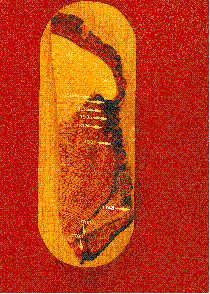 The dating of tree rings, by itself, is not much use unless the technique can be
applied to answer various questions in the earth and ecological sciences. For
example, what can we learn from past climate by looking at the varying widths of the
annual rings? What can we learn about past glacial activity by looking at the
growth patterns of trees that exist near glaciers?
The dating of tree rings, by itself, is not much use unless the technique can be
applied to answer various questions in the earth and ecological sciences. For
example, what can we learn from past climate by looking at the varying widths of the
annual rings? What can we learn about past glacial activity by looking at the
growth patterns of trees that exist near glaciers?
At the right is an example of a partial cross section taken from a living ponderosa pine
tree from the Chiricahua Mountains in southeastern Arizona. The right side of the sample
shows indications that this tree was burned by several forest fires. By extracting a small
section from the tree, dendrochronologists can date the exact year in which each of these fires
occurred (marked by arrows on the sample). Land management agencies, such as
the U.S. Forest Service and the National Park Service, can therefore use this
information when developing fire management plans. By knowing how often fires occurred
in the past, agencies can plan how to manage fires in the future.
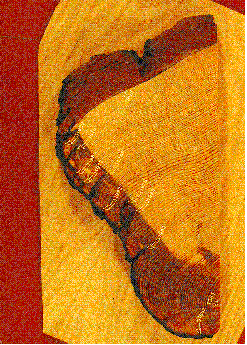
But forests fires are not just limited to the western United States... on the right
is a cross section from a pine tree that grew in the Sierra Madre in northern Sonora,
Mexico. The arrows, once again, point out the scars left in the tree rings by
the low intensity fires.
Such low intensity, surface fires were actually beneficial to the forests, not just to those
in Mexico, but all over the world. During recent decades, ecologists have learned
that forest fires were a pervasive phenomenon in practically all forests of the world,
even the rainforests. Humans have severely disrupted the natural pattern of fire across
the landscape, especially during the last 100 years. Therefore, if forests are
to be returned to their more "natural" state, fire will have to be reintroduced. The
consequences of not doing so could lead to more high intensity, catastrophic
crown fires that we often see on the news.
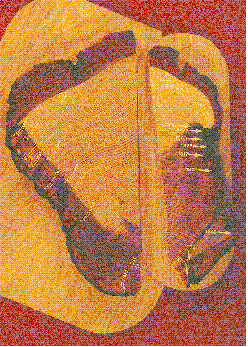
When we compare the two samples side by side, we see an interesting situation. Fires
have been occurring regularly in the forests of northern Mexico throughout the 20th
century. In the sample taken from the Arizona forests, there has been a greater attempt
at fire control, causing practically all 20th century fires to be suppressed. Note
the large curl of growth on the sample to the right of the image. This is called the
"Smokey Bear Effect" because no fire scars are present during the last 100 years or so.
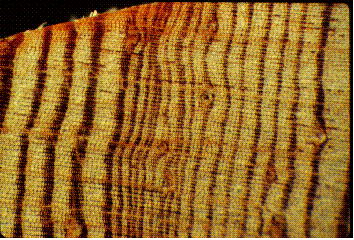
Changes in tree growth rates as seen in their tree rings also supply clues to forest
ecologists about possible disturbances that may have affected the forests. The image on the right
shows a closeup of tree rings for a shortleaf pine (Pinus echinata) tree
growing in Clemson, South Carolina. Growth is from the left to the right.
The abrupt decline in tree growth rates, marked by the narrower rings in the center of
the image, suggests some event occurred during the life of the tree that killed or damaged
many of the pine needles, reducing its ability to grow. Note how some rings
appear to "pinch out" or disappear - these are known as "locally absent rings."
The disturbance event could be related to storm dmage caused by high winds or perhaps
some insect defoliator may have attacked the tree as well.
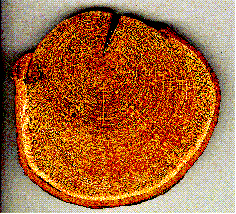
Finally, tree rings can also supply forest ecologists with information about
wildlife. The cross section on the right is a red oak sampled at the Adrian J. Rogers
Memorial Woodlot in Ashland, Wisconsin. The scar at the top of the sample was
made by a porcupine that was feeding on the inner cambium, the softer tissue just inside
the bark. Using tree-ring crossdating methods, ecologists can determine the exact
year in which the porcupine damaged the tree.
All graphics and text on these pages © 1996 by Lori Martinez, Laboratory
of Tree-Ring Research, and The University of Arizona. Last updated February,
2000. All rights reserved.
 The dating of tree rings, by itself, is not much use unless the technique can be
applied to answer various questions in the earth and ecological sciences. For
example, what can we learn from past climate by looking at the varying widths of the
annual rings? What can we learn about past glacial activity by looking at the
growth patterns of trees that exist near glaciers?
The dating of tree rings, by itself, is not much use unless the technique can be
applied to answer various questions in the earth and ecological sciences. For
example, what can we learn from past climate by looking at the varying widths of the
annual rings? What can we learn about past glacial activity by looking at the
growth patterns of trees that exist near glaciers?


